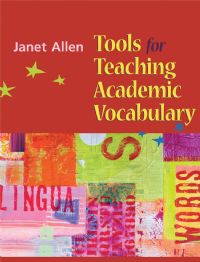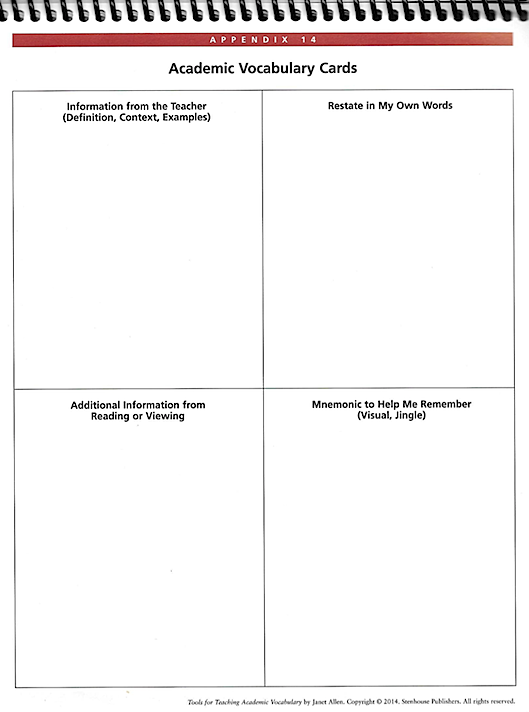An Amazing Toolkit for Teaching Vocabulary
Tools for Teaching Academic Vocabulary
By Janet Allen
(Stenhouse, 2014 – Learn more)

“One of the most crucial services that teachers can provide, particularly for students who do not come from academically advantaged backgrounds, is systematic instruction in important academic terms.” (Marzano & Pickering, 2005)
Teaching vocabulary is more than giving students a list of words to be defined and memorized. It’s more than attempting to choose the correct word from a word bank or filling in the blank in a vocabulary workbook. Vocabulary acquisition is not a still life painting but an active, ongoing process.
Vocabulary’s place in the Common Core

- Reading Anchor Standard 4 requires students to “Interpret words and phrases as they are used in a text, including determining technical, connotative, and figurative meanings, and analyzing how specific word choices shape meaning or tone” while…
- Reading Anchor Standard 10 requires students to “read and comprehend complex literary and informational texts independently and proficiently” and ….
- Language Standard 4 asks students to “determine or clarify the meaning of unknown and multiple-meaning words and phrases by using context clues, analyzing meaningful word parts, and consulting general and specialized reference materials, as appropriate.” In addition…
- Language Standard 5 asks students to “demonstrate understanding of figurative language, word relationships, and nuances in word meanings.”
What doesn’t work in vocabulary instruction
The importance of vocabulary instruction is difficult to dispute, but the methods of an effective program of vocabulary instruction still remain in question. In the past, vocabulary instruction was often unplanned and/or driven by content area textbook assignments. Unfortunately, some teachers still rely on word lists, workbook pages, or vocabulary tests. The sad part: this work is often tedious and time consuming but doesn’t result in long term memory acquisition or application. It is often lost quicker than it was “learned.”
The question is where, when and how do you begin such a daunting task? It has been estimated that 80% of comprehension in nonfiction is dependent upon understanding the vocabulary. Students won’t be able to understand the gist of what they are reading unless they understand the vocabulary.
In fact, for the brain to store new information as a permanent memory, it has to be connected to something already known. How do you as an educator provide this connection? How can you make it meaningful to students who are at different levels of comprehension and vocabulary acquisition? We know there isn’t enough time in the day to teach all the words with an equal amount of exposure, practice, and use.
What does work: Janet Allen’s new book

As vocabulary increases, the domino effect begins. Vocabulary increases, learning increases, students want to learn more about vocabulary, and vocabulary instruction actually becomes fun.
Allen’s spiral-bound resource is not a scripted program but an amazing toolkit that helps students become cognizant of how to increase their competence in vocabulary acquisition. Her book is grounded in current research with practical ideas to help students become proficient in language arts literacy. It is arranged in a clear, concise, teacher-friendly format.
How the toolkit is designed
The flipbook begins with an overview of the components of a research based vocabulary program and then defines the four types of vocabulary: general academic word types, domain/discipline specific words, topic specific words, or text specific vocabulary. Following the introductory materials, instructional tools are included to help support teaching each specific type of academic vocabulary. (See the table of contents.)
Each tool/module is presented on a single page, broken into three subsections:
- what the strategy is
- how it could be used in the classroom
- when\why to apply the strategy.
Allen provides both blank and sample graphic organizers for the tools, arranged in the back of the flipbook as 51 “appendices.” Each of these reproducibles is presented in a clear, concise layout. (You can see the design of the book by going to the publisher’s page and clicking “Preview Online.” This will download a PDF with four modules and their appendices.)
There’s an expression my mother used to use. “The proof is in the pudding.” Does it work? Is it teacher friendly? Does it promote vocabulary acquisition? The only way to find out is to try it and see the results. I decided to give it a try using the Academic Vocabulary Cards while teaching geometric principles in math. My students gave it a “thumbs up.”

A cross-curricular resource
Vocabulary instruction belongs to all disciplines, and Allen’s Tools for Teaching Academic Vocabulary is a must have for teachers of all disciplines. Each of the strategies is practical and authentic and can be used across the curriculum to improve vocabulary instruction and application.
I haven’t had the opportunity to meet Janet Allen, but hope to someday so I can thank her for providing teachers with resources that help our students become more proficient without adding overwhelming stress. She remembers what it is like being a teacher. I’ll also thank her for her honesty and candor. She continues to amaze me through her books.
Read another MiddleWeb review of Janet Allen’s book
“A Guide to Teaching Vocabulary for Non-ELA Teachers”
Linda Biondi is a fourth grade teacher at Pond Road Middle School in Robbinsville, NJ, and a long-time Morning Meeting practitioner. She’s also the recipient of several educational grants, a Teacher Consultant with the National Writing Project and a participant on the NJ Department of Education Teacher Advisory Panel. She recently shared her thoughts about the Common Core at the NJ SDE website.


































I love these books. So valuable and always worth sharing out with other teachers.